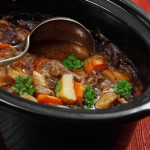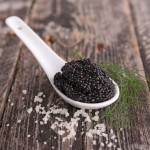Slow-Cooker Meat Cuts
It’s winter and there’s nothing quite like coming home to a hot meal. You count on your slow-cooker for delicious, almost no effort dinners and it can be tempting to throw just about any ingredients into these amazing appliances. BUT for the tastiest results, you need to know which meats do best in it. Delivering low, even heat over a long period of time, slow-cookers break down the connective tissue in typically tough cuts of meat, making them extremely tender. Here is a quick guide to great cuts of meat for your slow-cooker. The good news is that these cuts are often less expensive which, along with saving you time and energy, will also save you money.
Beef: Slowly cooked brisket becomes incredibly tender. Look for marbling. The white steaks of fat are what adds flavor. Beef chuck is another favorite for long braises.
Chicken: Go with dark meat. Thighs and drumsticks are cheaper and richer in flavor than white meat and stand out in soups and stews. Brown or remove the skin before cooking for the best results.
Lamb: Cooked low and slow, lamb shanks become rich and complex flavors. Have your butcher slice them crosswise to fit into your slow-cooker. Lamb shoulder is also a great choice for slow-cooking.
Pork: Always a classic, pork shoulder is a tough cut that becomes silky and flavorful after hours spent simmering in its own juices.
For most of us, it’s cold outside so bring out your slow-cooker and let it work its magic while you’re busy doing other things.
"Work With What You Got!"
© Victoria Hart Glavin Tiny New York Kitchen
Season With Worcestershire Sauce
Think of Worcestershire sauce as the “Fish Sauce” of American cooking. Worcestershire sauce is probably one of the most underused condiments. The sauce is a fermented mix of vinegar, molasses, anchovies, and other seasonings that adds great flavor to a dish without adding many calories. I often add a splash to salad dressings, marinades, and sauces, or use it to season ground meat for meatloaf or burgers. Just go easy because it’s high in sodium.
"Work With What You Got!"
© Victoria Hart Glavin Tiny New York Kitchen
Food is to the soul what words are to the mind. – Tiny New York Kitchen
A sandwich doesn’t have to be full of fat and calories. Replace high-fat mayonnaise with one of the reduced-fat varieties. You may want to stir in some chopped fresh herbs into reduced-fat mayonnaise for a flavor boost. You may also want to hold the mayo and spread your bread with mustard, as mustard is naturally low fat. You may also want to try a spread of non-fat yogurt mixed with a bit of mustard. Chutney, delicious by itself or when blended with mayonnaise or mustard, adds a sweet and spicy dimension to a sandwich.
Many lunch meats are high in sodium and calories. Look for alternatives such as grilled vegetables or skinless chicken breast, roasted turkey breast, or shrimp in a low-fat dressing. Another good alternative is water-packed tuna.
Cheese is a high-fat sandwich ingredient that should be eaten in moderation. Choose lighter cheeses such as Swiss or low-fat cheese.
Rather than ordering your sandwich at the deli counter, take a stroll by the salad bar. There are many candidates for a great sandwich just waiting to be piled onto bread (or into a pita) and drizzled with low-fat dressing.
A few healthy choice ingredients are: artichoke hearts, roasted peppers, pepperoncini, sprouts, shredded carrots, asparagus, sliced tomatoes, and tofu.
"Work With What You Got!"
© Victoria Hart Glavin Tiny New York Kitchen
Today is the end of the holidays. I didn't really feel like making a big Sunday dinner so I made this simple and delicious Ham, Bean & Pasta Soup. It certainly hit the spot!
“Where words fail, music speaks.” -Hans Christian Andersen
Love. Appreciate. Be Thankful. – Tiny New York Kitchen
For last year’s words belong to last year’s language and next year’s words await another voice.
— T.S. Eliot
Tiny New York Kitchen Wishes You A Very Happy New Year. May 2015 be filled with good health, love, and prosperity.
New Year’s Eve is about celebration, which most definitely calls for caviar and champagne. If you’re having a party or small get-together here are a few important tips about caviar.
Keep it simple! When serving caviar, keep it simple. You certainly don’t want to spring for something so speak jut to cover up the flavor with a lot of overkill. Caviar is intensely flavorful, and it goes well with crème fraiche or sour cream and blini. Try it with small boiled potatoes, seafood, soft or hard boiled eggs, or buttered pasta. Caviar can be used almost like a precious garnish, which can also be a great way to stretch out a small amount of it.
Keep it cool! When you bring caviar home, place in the refrigerator immediately in its tin. Place in the coldest part of your fridge, which is usually in the back of the deli drawer. If you’re making hors d’oeuvres, make sure to work quickly and serve immediately or place the completed snacks back in the fridge so that the eggs are sitting out on the table or counter. If you plan on serving the caviar straight up, place the tin or place in another bowl over crushed ice. The caviar doesn’t need to be freezing cold, but should be kept cool so the eggs hold their shape and freshness.
No metal please! Probably the most important rule with caviar is making sure it doesn’t come into contact with reactive metal. You certainly don’t want your precious caviar tasking like metal. This also goes for that beautiful tiny metal spoon you’ve been dying to use. Traditionally, a mother-of-pearl spoon is used to serve caviar. If you don’t have a mother-of-pearl spoon then don’t fret. Wood, ceramic, and glass utensils all work. Just make sure whatever non-metal spoon you use is a dainty little thing.
Leftovers you say? Holy moly, if you’re lucky enough to have leftover caviar please don’t throw it out or freeze it. Eat some more the next day and go out and buy yourself a lottery ticket. Leftover caviar is like seeing a unicorn. There are a number of ways to enjoy it by tossing it with buttered pasta or top your scrambled eggs with it. The good news is that your leftover caviar should last in your refrigerator for about a week.
Happy New Year’s Eve!
"Work With What You Got!"
© Victoria Hart Glavin Tiny New York Kitchen















